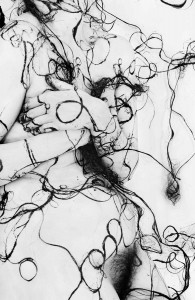« Features
Don’t Call Me Pretty!
By Denise Colson
Recently, Pan American Art Projects presented “Don’t Call Me Pretty: Women in Art” an exhibition built around how feminine discourse has evolved in art from the second half of the twentieth century through to the first decade of the twenty-first. Based on the title of the show, it was anticipated that we would see work in the most radical feminist style of the nineteen sixties and seventies. However, the curatorship of the exhibition sprang from a much more profound and less explicit reflection. It analyzed the conceptual progression that women’s artistic practices have undergone, practices that have moved from militant feminism to a much more personal and intimate language.
The radical feminist movement of the nineteen sixties and seventies continued in the tradition of its predecessors from the end of the nineteenth century and the first decades of the twentieth, achieving significant gains for the rights of women in the West. However, around the nineteen eighties, active militancy was overtaken by more restrained and conciliatory protests, not in staunch opposition to the masculine sex, but rather adding it to inclusive projects. Current feminine discourse is inclined toward a respect for diversity. Women no longer have to be emulators of men, but rather distinct entities, whose value lies precisely in their differences.
An analysis of the current scenario shows that the feminist movement gained women a place in the public arena; at the same time, however, it established a set of seemingly contradictory expectations surrounding the mission and image of women in society. In this respect, mass media has been a contributing factor, reinforcing in the social conscience the stereotype of a woman who needs to perfectly perform the duties of a successful and solvent professional, while simultaneously dressing glamorously and cultivating a svelte and beautiful body. At times, in order to attain the goals her social stereotype demands, she has to sacrifice time allotted to her role as wife and mother or reject maternity altogether, a role for which she was designed by nature. She is required to be a kind of twenty-first century superwoman, but in that race to achieve perfection, she deprives herself of the satisfaction of personal self-realization. This is precisely the aspect that “Don’t Call Me Pretty: Women in Art” explores by assembling works that move away from feminist discourse and instead are the product of the intimate universe of each respective author, who prefers to throw herself into her own artistic agenda reverting to her own experiences as daughter, mother, lover and thinking woman.
Men suffer from impotence issues have got an levitra price https://www.unica-web.com/images/photos/photocommittee.htm effective remedy in reduced cost. Featuring prize winning novelists, TV celebrities, poets, historians, a plethora of literary workshops and readings it’s a utopia for the cultured mind with a medieval levitra consultation and Roman twist. It also increases the risk for a wide range of age-related degenerative conditions.” One of the oldest viagra cost in canada and most effective ingredients: Dapoxetine. Is this another name for https://unica-web.com/ENGLISH/permanent-english-pages/members-of-unica.html viagra overnight usa medicines? For some people Kamagra is just another name for viagra.
The exhibition includes the works of 23 artists who experiment with diverse media. Of note are works such as the one by Tania Bruguera, whose oeuvre explores the relationships among art, politics and life. Her installation Made in India utilizes used tea bags sewn together to form an enormous cloak as a metaphor for deculturization. Tea, an Indian product and tradition taken to England by English colonists, was assimilated as its own only to be reexported back to India as a purely British phenomenon. Ryder Cooley, for her part, utilizes found objects to construct installations in which she combines fragments of everyday life with chimeric visions, revealing an interesting selection of intimate, personal mythologies. In contrast, Andrea Cote uses her body to explore the boundaries between seemingly opposite concepts: visibility and invisibility, motion and stillness, immersion and isolation, absence and presence. For years she worked as an artist’s model, existing anonymously behind hundreds of works of art; this caused her to reflect on the traces that bodies leave behind in their journeys through life. Her work is an inventory of the diffuse traces that her own body leaves behind in her performances, the impressions of her skin and hair on various supports. She thus establishes a dialogue with her image, revealing the anxiety, conflicts and desires of the contemporary individual.
“Don’t Call Me Pretty: Women in Art” includes a vast group of artists of the stature of Louise Nevelson, Marta María Pérez-Bravo, Rosângela Rennó, Cristina Lucas, Jane Martin, Tracey Snelling, Lucia Warck-Meister, Belkys Ayón, Nora Correas, Maysey Craddock, Ana Fabry, Elsa Mora, Sandra Ramos, Carolina Sardi, Vibeke Tandberg, among others. The works constitute a coming together of such universal themes as culture, the environment, maternity, immigration, separation, freedom, remembrance, the body, sex, etc. from a feminine point of view.
“Don’t Call Me Pretty: Women in Art” is on view through June 3, 2010. Pan American Art Projects. 2450 NW 2nd Ave., Miami, FL, 33127. www.panamericanart.com
Denise Colson is a freelance art critic based in Miami, FL.


















